Praying Mantis have an intimidating appearance, with their alien eyes and saw-like arms and their reputation for brutally tearing apart their prey. This does beg the question, Do Praying Mantis Bite?
As a general rule, no praying mantis don’t bite. Although unlikely, they can bite when provoked, mishandled, or when they mistake your finger for prey. They have no venom meaning their bite is not poisonous and causes little harm to people. They can also scratch you with spikes on their front legs.
Praying mantis are really incredible little creatures. Although they rarely bite people they are ferocious when it comes to the intended prey.
We are going to take a deeper look into how praying mantis are able to feed on animals that are three times their size? Do they chew out the prey or suck the juices? Are they beneficial or a nuisance to farmers?
Read on as we uncover more.
Understanding The Praying Mantis
There are about 2400 species of praying mantises worldwide. They grow up to 5 inches long, but tropical species can reach up to 8 inches or more. The masters of disguise have five eyes and are mainly green or brown. Since they do not have a long lifestyle (about one year), they usually mate once, which happens in autumn or fall, and the females lay eggs in the same season.
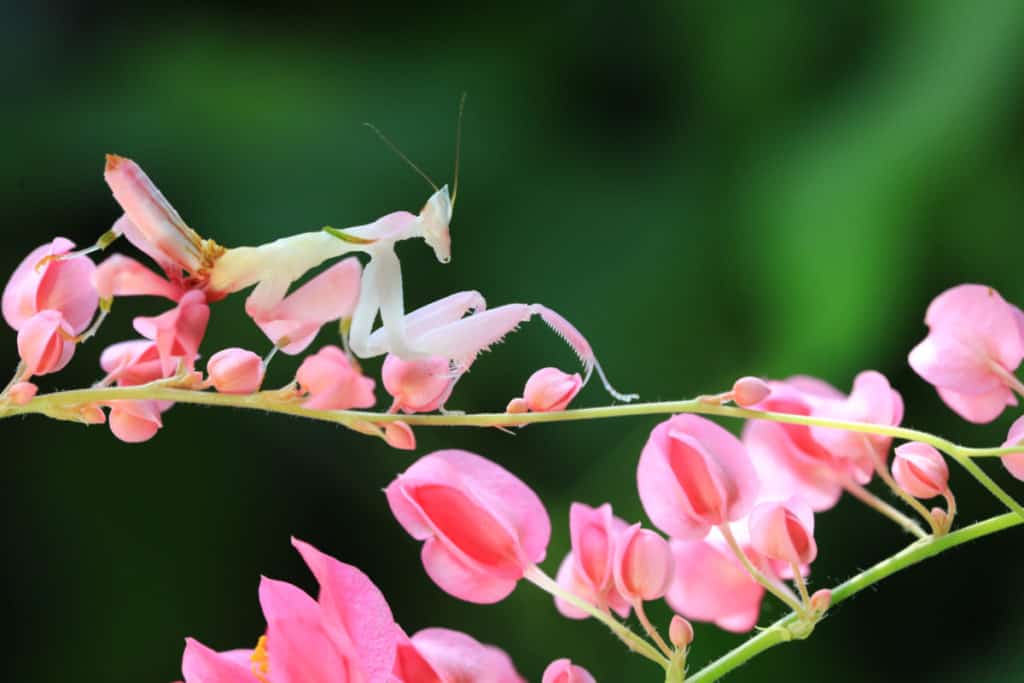
The eggs have a hard covering that protects them from the harsh winter weather and hatch in spring. They undergo incomplete metamorphosis; the hatched nymphs look like smaller versions of their parents. The larvae undergo several molts before reaching the adult stage. They usually sit on stems or leaves plants, shrubs, grasses, or flowers to hunt.
Although they sit still and look sluggish, they are swift when making a move to attack prey. Their dietary list consists of insects such as grasshoppers, spiders, lady beetles, crickets, and other small animals. Despite their hostility and intimidating look, they are some of the insects that are kept as pets.
If you are interested we have a whole article on the diets of praying mantis. Would you believe they are pretty good at fishing? If you want to check it out the article is called, What Do Praying Mantis Eat? (With Video Hunting A Fish)
Will Praying Mantis Bite Humans?
If a crawling insect makes you nervous, the sight of a mantis can be terrifying-the good news is that they only bite when provoked. A praying mantis is a non-aggressive carnivorous insect, even if it looks intimidating. Most people think they are dangerous due to their predatory behavior.
The voracious insect displays the deadliest behavior on prey or when threatened or attacked by a predator. They seem unbothered by humans since they can identify their preferred food sources. They can also scratch your skin with spikes on their front legs.
A bite by the mantis feels like a pincers’ grip. They do not have stingers but protect themselves with prominent forelegs, armed with countless sharp spines. The needle-like spikes can pierce through your skin.
The large-sized mantis is more likely to bite than the smaller ones. Their attack mode portrays their strength and fearlessness; they stand tall on their hind legs and start fanning their wings. Some species even produce a hissing sound to intimidate a predator. If the danger persists, they can move to bite you. In such a situation, it is better to leave them alone.
Do Praying Mantis Bite Pets?
Dogs are known to engage in a fight with the praying mantis. It is funny even the dogs are curious about these strange and unique creatures posing fearlessly ready for a fight. The mantis can also bite the dog if it feels threatened, but the bites are not toxic and it won’t hurt your canine friend.
However, it can cause gastrointestinal irritation if it happens to ingest the insect because of the sharp spikes on the mantis’s front legs. This is minor harm and you can deal with it by adding fiber to the dog’s diet to help in draining the bulk contents. If a pet is bitten, wash and sterilize the bites and ensure the area is kept clean.
How Do You Treat A Praying Mantis Bite?
If you are one of the unlucky ones to find yourself bitten by the peculiar predators, there are a few things you can do. On the bright side, the mantises are non-venomous, and there is no danger of allergic reactions or inflammation. However, you do not want its saliva hanging about on your skin. Here is what to do:
- Wet your hands with warm water;
- Apply soap and rather your hands thoroughly until they are well-covered in soap bubbles;
- Rub your hands together for about 20 minutes. Ensure you massage your wrists, back of your hands, and in between the fingers well;
- Rinse off the soap with warm water and dry your hands thoroughly.
Depending on the extent of the bite or scratch, you may require treatment for minor bleeding or take some painkillers to alleviate pain. You can protect yourself against potential bites by wearing gloves when handling mantises and wearing long pants and socks while in the woods or in tall grass.
If you are interested we have another article about the saliva of praying mantis. The article is called, Do Praying Mantis Spit?
How Do Praying Mantis Mandibles Work?
Praying mantis are deadly predators that feed on a variety of prey and other small animals and birds. They are fitted with long and broad mandibles with a triangular base designed to rip off the prey exoskeleton.
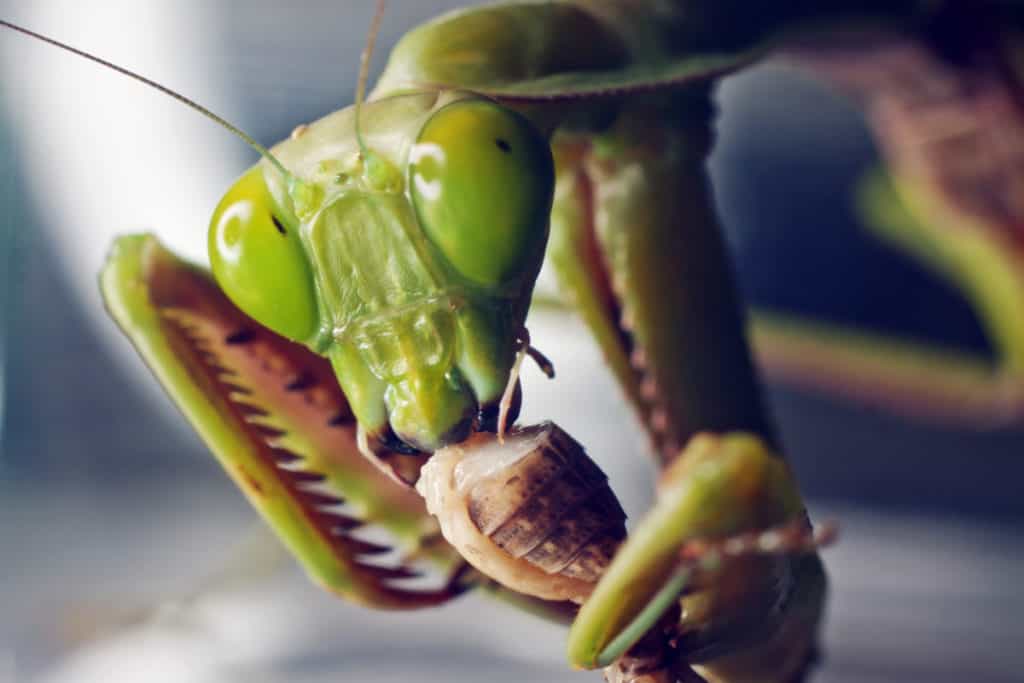
The right mandible has two molars and two sharp incisors. In between the incisors and molars, lies a sharp cutter plate that is linked to the right incisor and left molar.
The left mandible is broad and has four different incisors. Its molar lobe has two large teeth and one small tooth. The sharp cutter plate connects the right molar with the left incisor. Both the right and left mandibles are asymmetrical, and their lobes have different sizes.
Do Praying Mantis Bite, Chew Food, Or Suck Juices Out of Their Prey?
The praying mantis has an impressive dietary list of potential prey! It is quite incredible how such a small insect possesses such unique abilities. Shockingly, these skilled predators kill animals that are three times their size.
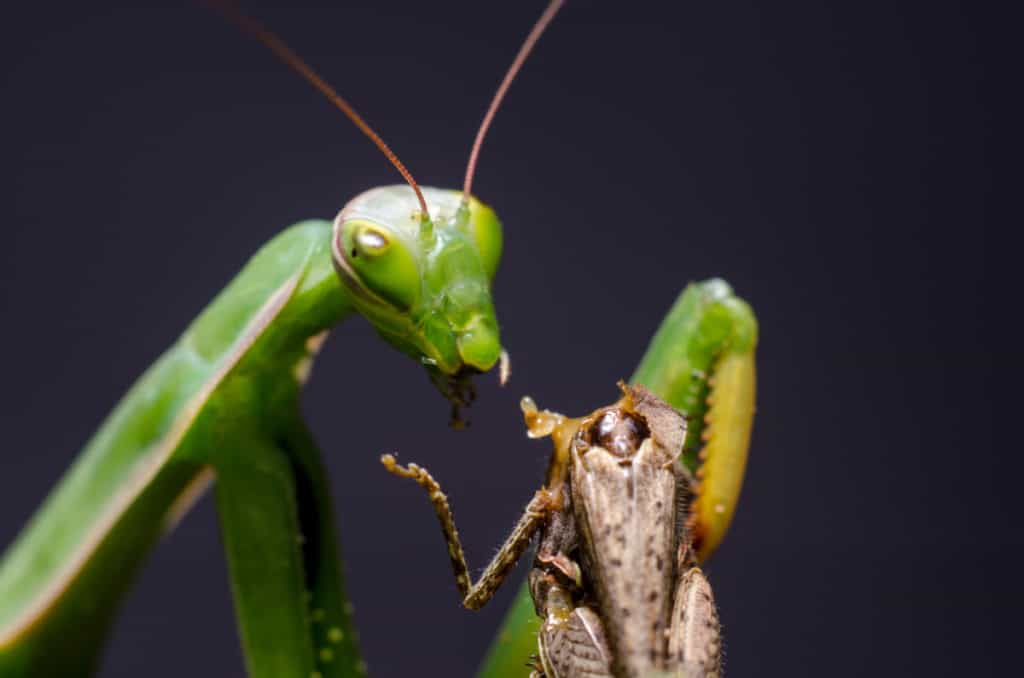
They ambush their prey, strike in a blink of an eye, and devour the prey slowly with their sharp mandibles. It takes about 50-70 milliseconds to strike and grasp its catch! The barbed teeth latch on the victim, making it difficult to escape.
They feed on insects, frogs, mice, small turtles, and even snakes. As they eat, the jaws open up and use the sharp mouthparts to bite and tear while the rest of the mouth moves the bits into the body for digestion. Their mouthparts are adept at tearing off the flesh of their prey. Their natural enemies include bats, birds, snakes, spiders, and lizards.
If you are interested we have written an article that makes direct comparisons between praying mantis and grasshoppers. The article is called, Grasshopper Vs Praying Mantis
What Makes The Praying Mantis Adept Predators?
Raptorial Legs
Its front legs also referred to as raptorial legs, are both for defense and offense. They are thoroughly equipped with rows of sharp spines that help them to grasp and spin their prey in place. They eat their victims from the head down.
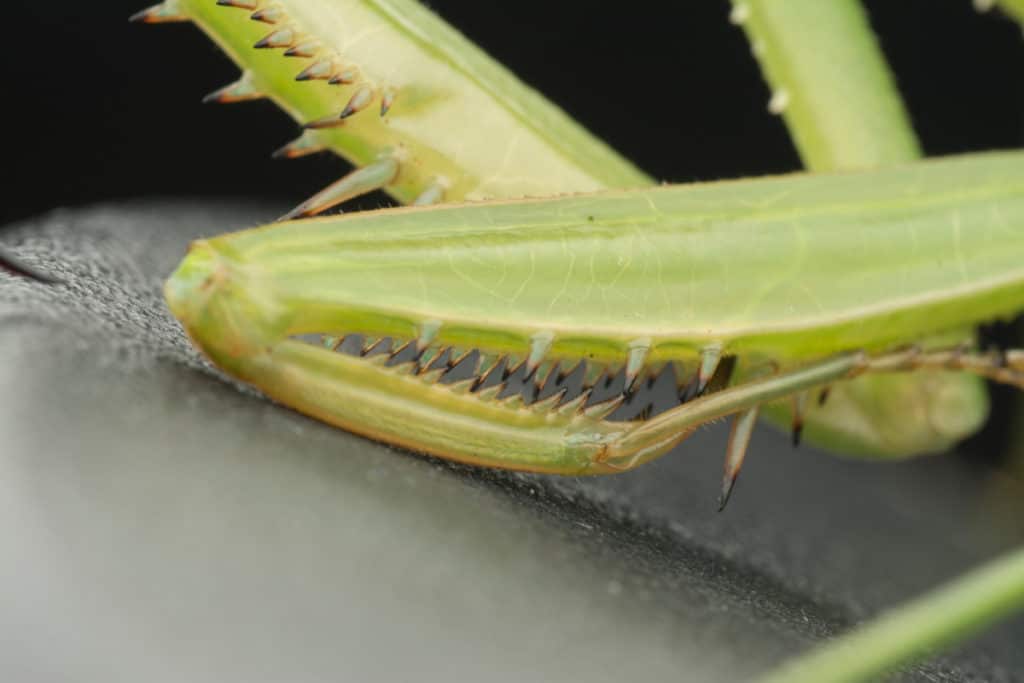
Excellent Vision
Their excellent vision helps them to see movement up to 60 feet away. They have two compound eyes and the other three simple eyes. The compound eyes, packed with thousands of ommatidia help them to locate their potential prey. They maintain an upright posture and remain stationary with folded arms. Two antennae located on each side of the head helps in navigation.
Sharp Mandibles
The sharp mouthparts are well adapted to bite, tear off, and chew their prey.
Ability To Camouflage
They are finely camouflaged, possessing green and brown colors that blend well with plants. Besides, their unique body shapes resemble leaves or branches. The sneaky insects disguise themselves to hide from predators and sneak on prey.
Female Praying Mantis Sexual Cannibalism
Even though all praying mantis are known to be voracious hunters, the female mantis is a step ahead. They display one of the deadliest cannibalistic behavior among insects, as they mercilessly behead and devour their male partners after mating or courtship.
Some research suggests that the females take their partners for an easy source of a meal, while some think that munching the head increases the duration of copulation. Females who bite off male heads lay more eggs since it gives them more nutrients to lay eggs. They lay 10 to 400 eggs, depending on the species.
Is It Safe To Hold A Praying Mantis?
You can hold a praying mantis, but you should be mindful of their safety and health. Their bodies are delicate, and their legs are easily damaged. If you are gentle and careful in your approach, you can pick them up and allow them to crawl on your hand. They are ideally safe to hold if not in a defensive mode.
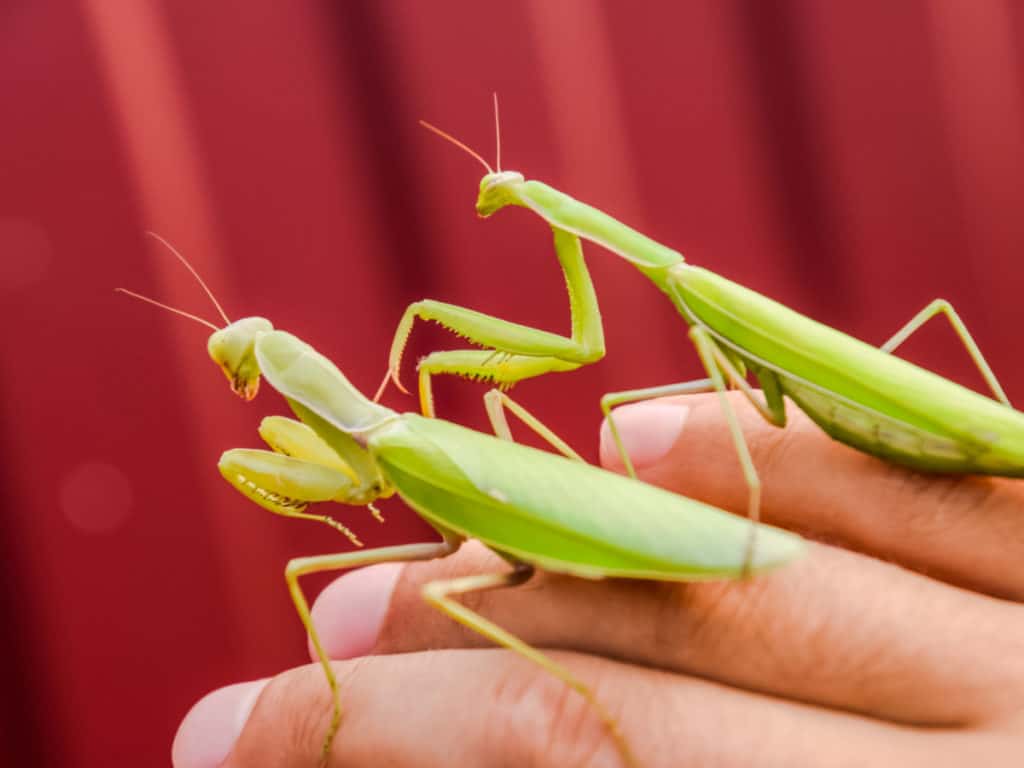
Like any insect or animal, a praying mantis will become defensive to protect itself. If it sees you as a threat, it will stand tall, stretch its front legs, spread its wings, and open its mouth wide. By taking this posture, it hopes you will leave it alone but if not, it will attack you.
If you like the idea of handling bugs then it might be worth checking out another article we have written about petting bumblebees. The article is called, Can You REALLY Pet A Bumblebee?
Yes, You Can Raise Praying Mantis As Pets
Lately, insect enthusiasts are keeping praying mantis as pets. Many pest stores are selling them and you can find a complete praying mantis starters kit online. You can also buy the mantis nymph or eggs from various garden centers.
Their life cycle is quite interesting: watching the eggs hatch and molts transforming is a great learning experience. Keeping them as pets requires a container, a natural environment, a heated environment, especially in cold months, food, and water. However, you need to breed them since they hardly live for a year. Worth noting is that each species of praying mantis requires specific conditions to thrive.
Breeding praying mantises requires male and female pairs that mature around the same time. You also need to ensure that the females do not cannibalize the males before mating takes place. Once the females lay eggs, you then take care of the eggs until they hatch into nymphs.
Are Praying Mantis Beneficial To Farmers?
The master predator plays a vital role in the ecosystem and environment. They are also known as terrific pest exterminators hence preventing harm to the crops.
They eat aphids, invasive beetles, crickets, grasshoppers, and other insects. Since they eat indiscriminately, they may also feed on beneficial bugs, which can also make them a nuisance to some farmers.
How Do You Get Rid Of Praying Mantises?
Although they have an inbuilt population mechanism through female eating males, sometimes you may find the number of praying mantis in your garden overwhelming. Here are some of the ways you can reduce or get rid of them:
- Remove them by grabbing them with a gloved hand and relocating them somewhere else. You may give other gardeners who may want the mantis.
- Increasing their predators such as insectivorous birds. Birds that prey on them include robins, larks, thrushes, and nightingales. You attract them by placing bird feeders in your garden and the surrounding.
- Get rid of insects from your garden. If there is no source of food, they will leave to search for food.
Myths Surrounding The Praying Mantis
Due to its unique appearance, the praying mantis is associated with many interesting stories from different cultures around the world. The word mantis is an ancient Greek word meaning a seer or prophet. They were believed to lead the lost home in the Greek tradition.
The tribes in South Africa revered the mantis and termed it as a God. In China, the consumption of roasted mantis is thought to cure bedwetting and other illnesses. Due to its hunting prowess, it has also been an inspiration for Chinese martial arts styles. In some parts of Africa, it is considered good luck when a praying mantis lands on you.
Other Facts About Praying Mantis
Praying Mantis Only Have One Ear
These fascinating insects have only one ear, which is located underneath their belly. Due to its location, it is unable to distinguish the direction of a sound. However, they can detect ultrasound produced by echolocating bats and can escape.
Praying Mantis Only Use Four Legs To Walk
The master predator has six legs. Amazingly, only four of them are used for walking; the two front legs are for capturing and holding prey.
In The Temperate Regions Praying Mantis Overwinter As Eggs
Female praying mantis lay their eggs on twigs or stems in the fall and then cover them with a protective substance, which she secretes from her body. It forms a protective case that allows the offspring to develop over the winter.
The eggs are easy to spot from fallen shrubs, and if you bring them to your warm home, tiny mantids begin to emerge.
Can Praying Mantis Be A Nuisance In Our Gardens?
The praying mantis consumes many pests in our gardens, but they feed on them indiscriminately, meaning they may end up eating the beneficial insects. It may end up eating bees and butterflies that help in pollinating our crops. They may end up doing more harm than good.
Do Praying Mantis Only Consume Live Food?
Praying mantis cannot feed on dead insects or animals. They love to eat their prey while it is still moving.
Are Praying Mantis Solitary Insects?
Praying mantises always walk alone and are most active during the day. They only pair during the mating season.
The Wrap Up
Praying mantis are scary creatures with incredible hunting abilities. When it comes to human beings, they are practically harmless. They only bite when provoked. They are beneficial in gardens and farms by feeding on the invading bugs. You can also allow them to go for a ride on your shirt or arm.
Amazingly they are the most popular pets in the insect world. They can be found worldwide and are adapted to different environments, but they are masters of disguise.
If you would like to know more about other bugs that might bite check out some of the articles we have written that are linked below:
Do Ladybugs Bite? They’re So Cute, Surely Not!
Sources
https://en.wikipedia.org/wiki/Mantis
https://www.scienceabc.com/nature/animals/do-praying-mantis-bite.html
https://blog.prepscholar.com/praying-mantis-eat-eggs-facts
https://stevenhartmanbi300.weebly.com/praying-mantis-biology.html
https://explorationsquared.com/can-a-praying-mantis-bite/
https://wildlifeinformer.com/can-a-praying-mantis-hurt-you/
https://www.treehugger.com/wondrous-facts-about-praying-mantises-4858807
https://howtogetridof.net/praying-mantis/
https://sujo-old.usindh.edu.pk/index.php/SURJ/article/viewFile/1601/1453
